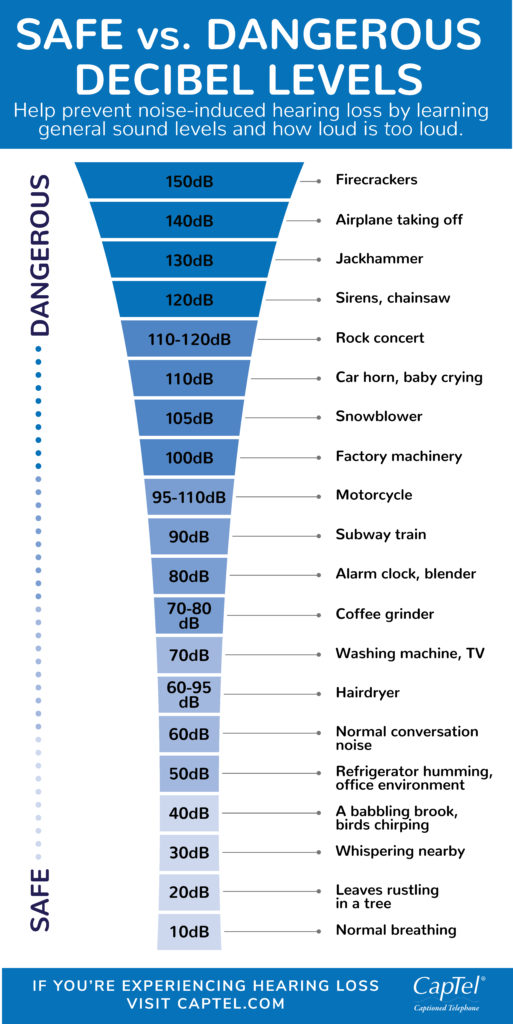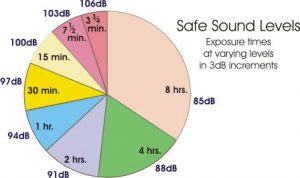

How loud is too loud? Find out from the noise simulator here.įor a more in-depth look at loud sounds, visit the NOISE database which brings together hundreds of noise measurements from around the world. Noise above 70 dB over a prolonged period of time may start to damage your hearing. Because of this, you can easily establish the decibel levels which are safe for your ears. On the surface, this decibel level may not sound like much, but in reality, this is loud enough to interrupt a normal conversation. Most dishwashers range from about 46 to 60 decibels.

Most governments regulate noise exposure for safety reasons and the most commonly used maximum acceptable noise exposure level is 85 decibels over eight hours (a typical working day). A decibel (dB) is a logarithmic unit that is used to describe levels of sound. How long can you listen without protection? The table shows the length of time we can safely be exposed to these sounds before permanent damage is likely to occur. The table below, the graphic and the poster to the side give examples of various everyday sounds and their typical loudness levels in decibels. To know if a sound is loud enough to damage your ears, it is. However extended or repeated exposure to sounds at or above 85 decibels (approximately the level of a vacuum cleaner) can cause hearing loss. points of reference measured in decibels 0 The softest sound a person can hear with normal hearing 10 normal breathing 20 whispering at 5 feet 30 soft. Experts agree that continued exposure to noise above 85 dB over time, will cause hearing loss. 110 decibel Serious hearing damage if sustained for more than 1 hour. 120 dB Human pain threshold, loud rock concert.

Sounds of less than 75 decibels, even after a lengthy exposure, are unlikely to cause hearing loss. 130 dB Jet take-off (100 meters), gun blast at close range. This will ensure that your ears are safe at all times. This always applies, whether or not your workers are wearing hearing protection. Learn more about hearing damage, including tinnitus and hearing loss, from excess noise through HHF’s Keep Listening campaign.Sound is measured in units called decibels (dB). If you have a decibel meter in your home you will be able to check on the levels conveniently at any time you want. While these guidelines and comparison are helpful, a basic rule of thumb is common sense: If it sounds too loud, it is too loud. With maximum readings actually as high as 119 dB on platforms and 120 dB on rides-based on actual recorded data within the sample-the subway system is an auditory minefield. The samples show the average noise levels on all subway platforms and on all subway rides (inside subway trains) is between 72.5 and 76.5 dB and between 74.1 and 75.8 dB, respectively. Most of the articles I’ve seen say to keep noise under 60 decibels but baby seems to calm more easily with slightly louder white noise.
Safe decibel levels pro#
HHF used Decibel Meter Pro to record the noise levels of hundreds of New York City subways. Safe decibel levels for infants My husband and I are in a small debate over what is a safe noise level for the sound machine we use for our one month old baby. 85 Decibels (dB) - the Action Level where hearing protection is required. Can 100 decibels cause hearing loss What about 70 Three factors come into play: the intensity, the duration, and the distance.
Safe decibel levels professional#
Some apps even let you geo-tag the decibel level to a specific location, like your favorite restaurant or your workplace. about three feet, noise levels are probably exceeding safe levels and you. Decibel levels are important to professional users and homeowners alike who wish to avoid noise-induced hearing damage. As with a professional-grade meter, most phone apps can also show how the noise fluctuates over time, in real time, and provide numerical reference points that users can compare to their own sound levels.


 0 kommentar(er)
0 kommentar(er)
